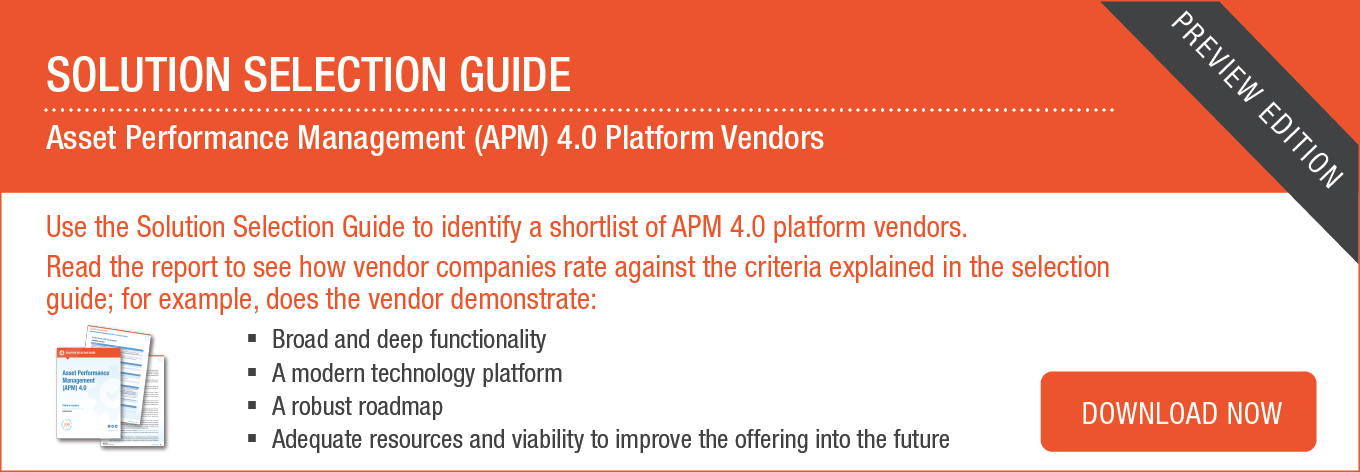Asset investment planning (AIP) is an approach and now a category of software applications to assess and prioritize capital investment options ― specifically investing in physical assets used to produce or deliver goods or services. Systems used for asset intensive CapEx planning is an outgrowth of financial planning tools that companies use to direct investment portfolios. The fundamental approach in the financial sector is to assign risk and reward probabilities to each investment option, then create an investment portfolio that can deliver the highest return given the investor's tolerance for risk. The industrial sector can apply this approach to capital investments of physical assets: determine the investment amount, calculate expected return, evaluate the risk that the asset will not achieve the return, and weigh that in context of other risks that the investment is meant to reduce or eliminate.
Click here to speak with Dan Miklovic.
LNS sees AIP as an element of asset performance management (APM) but specialist vendors in the area view themselves as a complementary solution. If a manufacturer has a narrow, traditionalist view of APM that may be the case but in the context of APM 4.0, AIP is really a critical component of good maintenance practice. Companies should use AIP to make long-term strategic decisions, while using the rest of the portfolio of APM capabilities to make mid- and near-term operational decisions. When an industrial enterprise is investing for reducing maintenance risks, it first needs to identify which assets pose the greatest operational risk, then decide which risks are deserving of scarce capital funds. Whether a company has a narrow APM view and sees AIP as a separate capability, or perceives APM as the entire suite of tools used to maximize return from its production assets, AIP is a critical tool to drive Operational Excellence.
When industrial companies tried to apply the same tools used by financial analysts to the problem of physical asset investments, they produced suboptimal results. The original industry-specific applications only generated financial risk/reward calculations based on investment dollar amount. When evaluating capital projects, rewards are usually a combination of actual dollars and soft benefits like reducing injuries or emissions, improving product quality, or speeding time to market in new product introductions. In some cases, a company can quantify the risk or reward in monetary terms, but most often it’s difficult to determine or articulate a value that would be widely accepted throughout the enterprise or industry.
Today’s industrial organization generally applies one of four AIP approaches for fixed assets:
- Traditional financial investment planning tools
- Traditional business planning tools used at the corporate level
- Project portfolio management (PPM) tools that may be specific to PPM or extend the capability of typical project management applications
- AIP software specifically designed to evaluate physical assets
Each approach has strengths and limitations for the industrial organization.
Traditional Financial Investment Planning Tools
These are tools used by financial investment portfolio managers to determine the optimal mix of investments to achieve investment goals. They can handle complex calculations, apply variability risk factors, and deliver high fidelity results. On the downside, they are complex, generally built for purpose, and usually not optimized to deal with soft factors. While used on rare occasion in the industrial sector, they are best suited for financial analysts in the investment community, not equipment asset planners in manufacturing companies.
Traditional Business Planning Tools
CFOs and corporate financial controllers have business planning tools to assess return on capital investments. These tools, now generally part of an enterprise software suite such as SAP or Oracle, are often already in use by a company and using them to evaluate physical asset investment tradeoffs is feasible. The main challenge is that these tools are designed for business planners and optimized for strategic investments. They don’t readily factor in soft benefits nor do they easily factor in dependencies. A tool like this is most often used to evaluate a small number of strategic options with no cascading benefits.
Project Portfolio Management (PPM)
PPM and more common project management tools provide for dependency modeling and thus offset one of the deficiencies of business investment planning tools. Used together many companies achieve satisfactory decisions about asset refurbishment and replacement. However, when not used in tandem with a traditional financial investment planning tool, PPM and project management tools fall short; they don’t provide for financial modeling. On occasion a company will supplement PPM with financial details in spreadsheets. A small to mid-size company can expect reasonable results with this approach, but only if the number of assets and project options are limited to just a few. As the number of assets and complexity increases, usability and effectiveness dramatically decline.
AIP Solutions Specifically Designed for Physical Assets
Asset investment planning software is an enterprise-grade solution specifically designed to evaluate asset care and replacement strategies. It can handle complex assets, high degrees of dependency, and a multitude of soft benefits. Furthermore, AIP solutions often offer the capability to create and evaluate what-if scenarios. There are two essential drawbacks with most AIP solutions: price tag and specialization; most AIP solutions are based on a particular industry, like oil and gas, or perhaps mining. On the upside, makers design them specifically for asset-intensive industries, usually with industry-specific models, and with a user interface suitable for a broad range of financial modeling skills.
When Industrial Companies Ask: Which AIP for Us?
The decision to invest in bespoke asset investment planning for manufacturing boils down to developing a business case; will an industry-specific AIP application yield measurably better financial decisions and improve overall ROI than the alternatives? Along with building the business case, companies considering AIP should also:
- Assess the degree of dependencies between projects
- Agree upon the importance of soft benefits in selecting components
- Document the availability, completeness, and necessity of ready-made models
- Apply proven solution selection best practices
